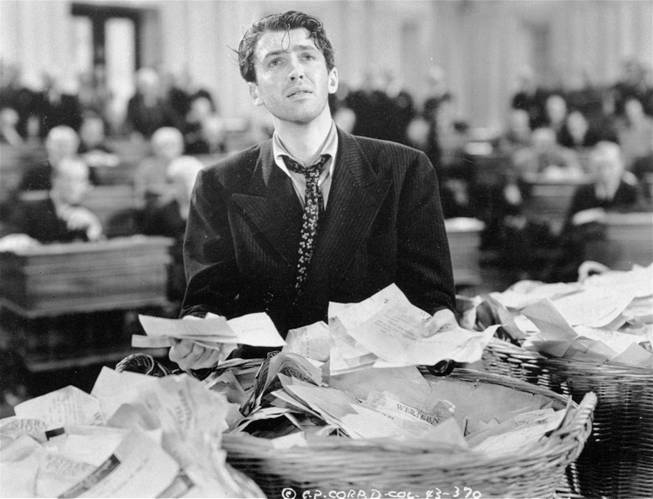
Columbia/AP
This undated black-and-white file photo provided by Columbia shows James Stewart in a scene from the movie: “Mr. Smith Goes to Washington.” The Senate has more filibusters than ever these days. But you’d hardly know it by watching the chamber on C-SPAN. Filibusters are procedural delays that outnumber lawmakers, used to try killing bills and nominations. They seldom look like the exhausted talkathon waged by the devoted senator portrayed by Stewart.
Thursday, Jan. 24, 2013 | 1 p.m.
WASHINGTON — From Jimmy Stewart's fictional all-night talkathon to real-life dramas over World War I and civil rights, the Senate's filibuster has played a notable — sometimes reviled — role in the nation's history. Now the slow-moving, famously deliberative chamber is on the verge of dialing it back — modestly.
Filibusters are procedural delays that outnumbered lawmakers use to try killing bills and nominations. But they seldom look like the exhausted speech delivered by the devoted senator portrayed by Stewart in the film, "Mr. Smith Goes to Washington."
In fact, the Senate has more filibusters than ever these days. But you'd hardly know it by watching the chamber on C-SPAN television.
These days, lawmakers intent on killing a bill simply inform majority Democrats that to pass the measure, they will need yes votes from 60 of the 100 senators. With Democrats controlling just 55 votes, nothing can pass without at least some Republican support.
And that has brought the Senate virtually to a standstill on a list of sweeping legislation, from tax hikes on the wealthy to limits on greenhouse gas emissions. The resulting gridlock helped inspire recession-weary Americans to slap the last Congress with some of the lowest approval ratings in history.
Party leaders on Thursday struck a tentative agreement to limit the use of filibusters when the Senate begins debating a bill and when it wants to try writing compromise legislation with the House. It would also speed approval of some nominations by reducing the amount of debate allowed after the Senate has voted to end debate.
But the pact would still let the minority party force majorities to get 60 votes to prevail. Still, the tentative deal on filibusters would clear the way for other legislation, like a $50.5 billion emergency relief measure for Superstorm Sandy victims.
Defenders of filibusters say the enormous power it gives to the minority party is what differentiates the Senate from the House, where rules give almost absolute power to the majority party when it remains united.
Opponents say the practice makes a mockery of the concept of majority rule. Democrats say today's Republicans use the tactic far too often, while GOP senators insist they employ it so frequently because today's Democratic leaders block them from offering amendments.
Numbers compiled by the Senate Historian's Office underscore how the practice has grown.
There were 73 votes to end filibusters — called "cloture votes" — in the two-year Congress that ended early this month. There were 91 cloture votes in the Congress that ran from 2009 to 2011, and 112 in the Congress that last from 2007 to 2009.
Each of those numbers exceed the number of cloture votes in any previous Congresses. The Congress that was in session in 1939, the year Stewart's movie was made, didn't have any such votes.
Originally, there were no rules that could stop senators from debating as long as they wanted.
President Woodrow Wilson persuaded senators to approve a rule in 1917 stopping such delays with a two-thirds vote. Two years later it was used for the first time, when senators used cloture to end delaying tactics holding up approval of the Treaty of Versailles, which ended World War I. And in 1957, South Carolina Sen. Strom Thurmond, then a Democrat, set a record by speaking for 24 hours, 18 minutes against the Civil Rights Act.
Despite his effort — which included reading the election laws of all the states — the measure eventually became law.
The number of votes needed to end filibusters was changed in 1975 to a three-fifths majority. That's 60 votes today.
The delaying tactics were used by a string of Southern senators to try thwarting civil rights legislation. The longest filibuster on record stretched over 57 days as Southerners used various tactics to unsuccessfully try blocking the Civil Rights Act of 1964. Over time, the maneuver has been used on dozens of issues including efforts to abolish the Electoral College, block a 1974 genocide treaty, grant pardons to Vietnam War draft evaders and to add an anti-abortion amendment to the Constitution.
There are few restraints on what senators can say while filibustering on the Senate floor.
According to a 1940 study, Sen. Huey Long of Louisiana used some of his time describing his technique for frying oysters. A 1992 filibuster on a tax bill by then Sen. Alphonse D'Amato, R-N.Y., that lasted 15 hours and 14 minutes, including his singing a rendition of "South of the Border."

Join the Discussion:
Check this out for a full explanation of our conversion to the LiveFyre commenting system and instructions on how to sign up for an account.
Full comments policy